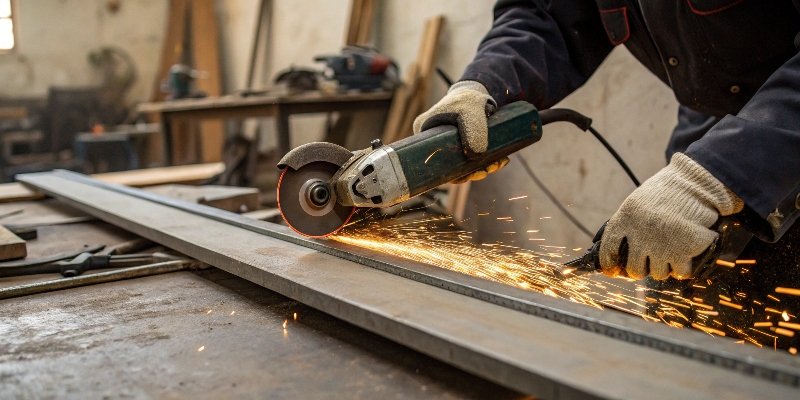
A dull saw slows down your work and costs you money in replacements. But what if you could restore a sharp edge using a tool you already have in your workshop?
Yes, you can absolutely sharpen a saw with an angle grinder. The key is to use the correct diamond grinding wheel, secure the blade properly, and apply a light touch at a consistent angle. This method is a fast and cost-effective way to restore a blade’s cutting performance.

It sounds simple, but doing it right is the difference between a sharp tool and a ruined one. The process requires a steady hand and attention to detail. A wrong move can damage the blade’s temper or geometry, making it useless. But don’t worry, I’ve been working with grinding tools for decades. I’ll walk you through the proper way to do it safely and effectively. Let’s get into the details.
What is the proper technique and disc to use for sharpening a saw with an angle grinder?
Using the wrong disc or a poor technique can easily ruin your saw blade. A damaged blade costs time and money to replace. Let’s make sure you get it right.
The proper technique requires a diamond grinding wheel, ideally 80-120 grit. You must clamp the blade securely, hold the grinder at a 15-30 degree angle, and use light, even strokes. Spend only 3-5 seconds per tooth to prevent overheating the metal.

Getting a professional-level sharpness with a handheld tool is all about control and using the right materials. Over my years at our factory, we’ve seen countless tools sharpened. The ones that last are always the ones sharpened with care. Let’s break down the process so you can do it like a pro.
Choosing Your Grinding Disc
This is the most critical choice. Do not use a standard abrasive disc meant for grinding metal. It will wear down too quickly and won’t give you the precision you need.
- Disc Type: You must use a diamond grinding wheel1. Diamond is one of the only materials hard enough to effectively grind the hardened steel of a saw tooth without quickly deforming.
- Grit Size: A grit of 80# to 120# is perfect. It’s coarse enough to remove material efficiently but fine enough to leave a sharp edge.
- Disc Size: Match the disc to the blade. For a common 125mm (5-inch) saw blade, a 100mm (4-inch) grinding wheel works best. It gives you better control and visibility.
The Sharpening Process, Step-by-Step
| Step | Action | Key Details |
|---|---|---|
| 1. Secure the Blade | Clamp the saw blade firmly in a bench vise or a specialized jig. | The teeth should be pointing up and be stable. Any movement will ruin the angle. |
| 2. Set Your Angle | Position the angle grinder at a 15-30 degree angle to the cutting face of the tooth. | This angle is vital for the blade to cut effectively. Try to match the original factory angle. |
| 3. Grind Gently | Turn on the grinder and bring it to the tooth with a light touch. Move it evenly along the tooth’s edge. | Do not press hard. Let the diamond wheel do the work. |
| 4. Control the Heat | Grind each tooth for only 3-5 seconds. | If the metal turns blue, you’ve overheated it and softened the steel. This is called annealing. |
| 5. Check Consistency | After every 10 teeth, stop and inspect your work. | Ensure the angle is consistent from tooth to tooth. An error of more than ±2 degrees will affect performance. |
Finally, always put safety first. Wear safety goggles and a dust mask. Stand to the side of the grinder, not directly behind it.
What are the risks of damaging a saw blade by sharpening it with an angle grinder?
A quick sharpening job
can easily turn into a disaster. A ruined blade means immediate downtime and the cost of a brand new one. You can avoid this by understanding the risks.
The biggest risks are overheating the teeth and grinding at the wrong angle. Overheating softens the steel, making it dull almost instantly. An incorrect angle destroys its cutting ability. Grinding the base of the tooth can also cause it to break off during use.

In our quality control department, we see how easily a blade’s integrity can be compromised. A handheld tool like an angle grinder puts all the control in your hands, which means the potential for error is higher. Let’s look at what can go wrong and how to make sure it doesn’t.
The Danger of Overheating
The sharp edge of a saw tooth relies on its hardness. This hardness is created by a heat-treating process at the factory.
- What is Annealing? When you grind a tooth for too long, friction generates intense heat. If the temperature exceeds 600°C (you’ll see the metal turn blue or straw-colored), you have effectively "annealed" it. This process softens the steel, making it unable to hold a sharp edge. A softened tooth will become dull again after just a few cuts.
- How to Avoid It: The rule is simple: short, light passes. 3-5 seconds per tooth is plenty. If you are sharpening many teeth, work in sections to let previous teeth cool down.
The Importance of Correct Angles
A saw blade is a precise tool. Every angle on the tooth is designed for a specific type of cut.
- Poor Performance: If you sharpen the teeth at an angle that is too steep or too shallow, the blade will either become aggressive and hard to control or too passive and slow to cut.
- Inconsistent Cut: If the angles vary from tooth to tooth, the blade will vibrate, create a rough finish, and put extra strain on your saw’s motor. This is why checking your angle every few teeth is so important.
Structural Damage to Avoid
This is a critical safety point.
- Do Not Grind the Gullet: The gullet is the curved valley between each tooth. This area is under a lot of stress during a cut. If you accidentally grind it and make it thinner, you create a weak point. This can cause the tooth to snap off and become a dangerous projectile. Only sharpen the cutting face of the tooth.
- Post-Sharpening Care: Once you’re done, wipe the blade down and apply a light coat of anti-rust oil2. The freshly ground metal is exposed and will rust quickly if left in a damp environment.
How does sharpening with an angle grinder compare to using a dedicated saw sharpening tool or file?
You have a dull blade, but what is the best way to bring it back to life? Choosing the wrong method can easily waste your time, money, or both. Let’s compare options.
An angle grinder is fast and cheap, especially if you already own one. A dedicated sharpener offers far better precision and speed but at a high initial cost. Hand filing is the cheapest option and can be very precise, but it takes the most time.

Here at my company, Reliable, we use different tools for different jobs. For mass production and ensuring our RL brand blades are perfect, we use high-tech dedicated machines. But for a quick fix or a prototype adjustment, our engineers often reach for an angle grinder. Each method has its place.
Comparing the Sharpening Methods
Here’s a simple breakdown to help you choose the right method for your needs.
| Method | Cost | Speed | Precision | Best For |
|---|---|---|---|---|
| Angle Grinder | Low (tool + diamond disc) | Fast (~30 min/blade) | Moderate (±2°), skill-dependent | Quick touch-ups on standard blades, cost-effective workshop maintenance, and jobs where perfect precision isn’t critical. |
| Dedicated Sharpener | High (professional equipment) | Very Fast (3x faster than grinder) | High (±0.5°), very consistent | High-volume shops, professional sharpening services, sharpening complex carbide blades, and when perfect results are a must. |
| Hand File / Whetstone | Very Low (file or stone) | Slow (~1 hour/blade) | High (with practice) | Small hand saws, fine-tuning specific teeth, jobs where no electricity is available, and for those who enjoy the craft. |
A dedicated sharpener is like a CNC machine for your blades—it guarantees every tooth is identical. This is the gold standard for performance. An angle grinder is a versatile power tool that gets you 80% of the way there in a fraction of the time and cost. A hand file is the traditionalist’s choice, offering great control for those with the patience to master it. The best method depends on your budget, your volume of work, and the level of perfection you require.
Are there certain types of saw blades that should never be sharpened with an angle grinder?
Not all saw blades are the same, and trying to sharpen the wrong one is a recipe for failure. You could permanently damage an expensive blade. Let’s clarify which ones to tackle and which to leave to the professionals.
Yes, you should avoid sharpening complex carbide-tipped blades with an angle grinder. Their intricate tooth geometries are nearly impossible to replicate by hand. Also, do not attempt to sharpen very thin or flexible blades, as the grinder’s force can damage them.

Working in a factory that produces everything from diamond blades to simple cut-off discs, I’ve learned that some tools demand specialized equipment. While an angle grinder is a fantastic multi-purpose tool, it has its limits. Pushing it beyond those limits is a costly mistake.
The Challenge of Carbide-Tipped Blades
Many modern circular saw blades have tungsten carbide tips brazed onto a steel body. These are extremely popular for their durability.
- Complex Geometry: These blades often feature complex tooth designs like Alternate Top Bevel (ATB) or Triple-Chip Grind (TCG). Each tooth has multiple precise angles that work together to produce a clean cut. Replicating these angles by hand with a grinder is nearly impossible.
- Brittle Material: Carbide is extremely hard, but it is also brittle. Applying uneven pressure or overheating it can cause the tip to chip or fracture.
- The Verdict: While you could potentially use a very fine diamond wheel to touch up a slightly chipped tooth, full sharpening of carbide blades should be left to a professional sharpening service. They use specialized CNC grinders3 that precisely restore the factory geometry.
Blades to Avoid for Safety and Practicality
Beyond carbide, there are other blades you should pass on.
- Thin or Flexible Blades: Some hand saws or specialty saws have very thin and flexible blades. The power and vibration of an angle grinder can easily cause these blades to chatter, bend, or warp permanently. A hand file is a much safer choice here.
- Specialty Metal-Cutting Blades: Blades designed for cold saws or other metal-cutting applications have unique tooth profiles and hardness treatments. Sharpening them incorrectly can lead to catastrophic failure when the blade is put under the extreme stress of cutting metal.
- A Note on the Grinder Itself: On a related safety note, never mount a wood-cutting saw blade onto your angle grinder. These tools spin at a much higher RPM than saws do, and using a saw blade on one can cause a violent and extremely dangerous kickback.
Conclusion
Sharpening a saw with an angle grinder is a great skill. Just be sure to use a diamond disc, maintain proper control, and know which blades are best left to the pros.
Written by
leeon
You may also be interested in:
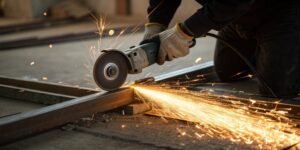
Can an angle grinder start a fire?
You use powerful tools like angle grinders every day, but the shower of sparks can be worrying. A single stray spark could ignite nearby materials,
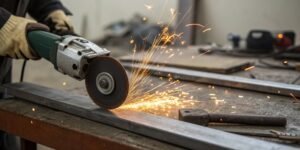
Can You Use an Angle Grinder Without a Shield?
Feeling the urge to remove your angle grinder’s guard for a tricky cut? That simple act could lead to a life-changing accident. Your safety is
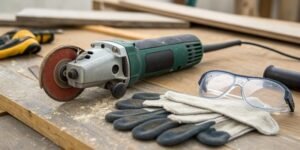
Are angle grinders dangerous?
Worried about the horror stories you’ve heard about angle grinders? These powerful tools can seem intimidating, and misuse can certainly lead to serious accidents. But
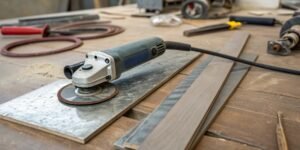
What are the real purposes of an angle grinder?
Your angle grinder sits in your workshop, but do you know its full power? You might be using it for just one job. This limits
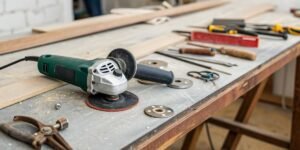
Should I buy an angle grinder for home related works?
Thinking about a tough home project? Cutting metal or tile by hand is slow and frustrating. An angle grinder could be your powerful solution for
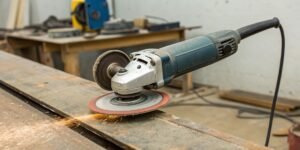
What is an angle grinder?
Are you confused by this powerful, versatile tool? You see it everywhere but are not sure what it does or if you need one. Getting
